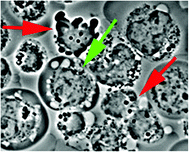Among the cellular responses to photodamage initiated by photodynamic therapy (PDT) are autophagy and apoptosis. While autophagy is a reversible process that can be both a survival and a death pathway, apoptosis is irreversible, leading only to cell death. In this study, we followed the fate of mouse leukemia L1210 cells after photodamage to the endoplasmic reticulum (ER) using a porphycene photosensitizer, where Bcl-2 was among the PDT targets. In wild-type cells, we observed a rapid wave of autophagy, presumed to represent the recycling of some damaged organelles, followed by apoptosis. Using shRNA technology, we created a Bax knockdown line (L1210/Bax–). In the latter cell line, we found a marked decrease in apoptosis after photodamage or pharmacologic inactivation of Bcl-2 function, but this did not affect PDT efficacy. Loss of viability was associated with a highly-vacuolated morphology consistent with autophagic cell death. Previous studies indicated pro-survival attributes of autophagy after low-dose PDT, suggesting that autophagy may be responsible for the ‘shoulder’ on the dose-response curve. It appears that attempts at extensive recycling of damaged organelles are associated with cell death, and that this phenomenon is amplified when apoptosis is suppressed.

You have access to this article
 Please wait while we load your content...
Something went wrong. Try again?
Please wait while we load your content...
Something went wrong. Try again?


 Please wait while we load your content...
Please wait while we load your content...